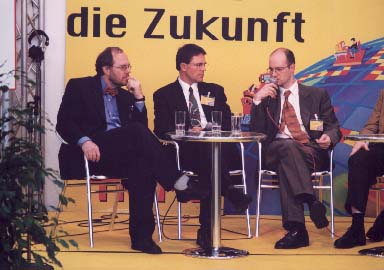
The Future of Learning & Training
Combining Visionary Anticipations with Teaching and Training Practices

Reinhard Keil-Slawik
Ulrich Bernath &
Joachim Hasebrook
presented
Innovative Settings and Modes
at
CeBIT HOME ‘98
from August 26 to 30, 1998
In a rapidly changing technological and economic world learning and aptitude are more than ever becoming determinants of the future. Learning as such is subject to changing demands. Next to "stockpiling knowledge" during a specific career period in highly specialised educational institutions, the ability to acquire and intensify the capacity of solving problems in a variety of co-operational contexts and learning settings is the new focus of attention.
People learn in educational institutions, on the job, at home and in their spare time. Even a customer learns in everyday business life. Provided these different spheres of learning are effectively connected in terms of pedagogical methods and technology, we will be able to face the challenge. We cannot just watch learning turn into a privilege of a few. It has to stay a phenomena of the masses that is embedded in social interaction. Learning is and will remain an encounter between people. Machines and media may simply prove supportive in the process.
At CeBIT HOME ‘98 innovative approaches in the face of future learning and training were introduced. There was no talking about distant visions or fantastic ideas but about trend-setting, feasible designs that demonstrate today what will be normal tomorrow. Visitors discovered the various prototypes: public spaces turned into multimedia learning and training centres. A specifically arranged programme clarified contexts, illuminate backgrounds and stage innovative learning modes. Learning settings, commodities and procedures standing for "Best Practice" and for "The Future of Learning & Training" were presented. Substantially, three areas illustrated the variety of learning and training settings and modes and were employed to demonstrate how learning arrangements will serve people in a learning society. These three show areas comprise:
 |
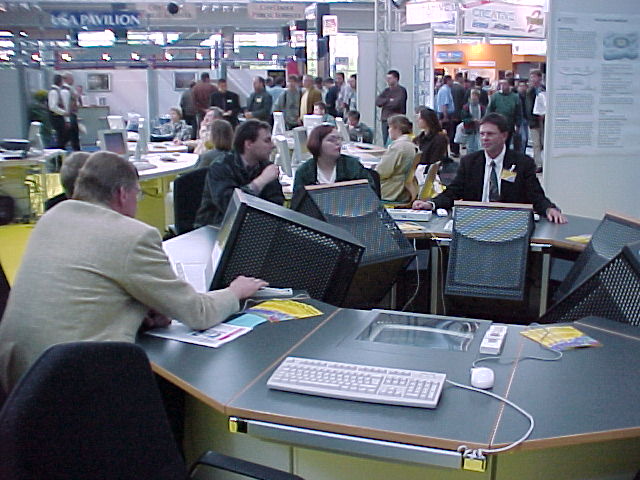 |
Teaching and Learning in an interactive teaching theatre
Cooperative learning in a multimedia classroom and conference setting
Learning in the business world of banks
Learning in the interactive teaching theatre
Learning is a social process, complemented by individual activities. Whenever people meet, they learn from each other; and at places where people learn, they must be able to communicate. Learning needs media to imagine and recall facts and to keep insights. Exchanging experiences and views with each other means to refer to common documents and to make own material available.
The interactive teaching theatre supports a many-to-many communication instead of a traditional one-to-many-in-silence communication. Networked personal computers supported by an interactive control panel enable students to be sender as well as receiver, speaker as well as listener, and presenter as well as
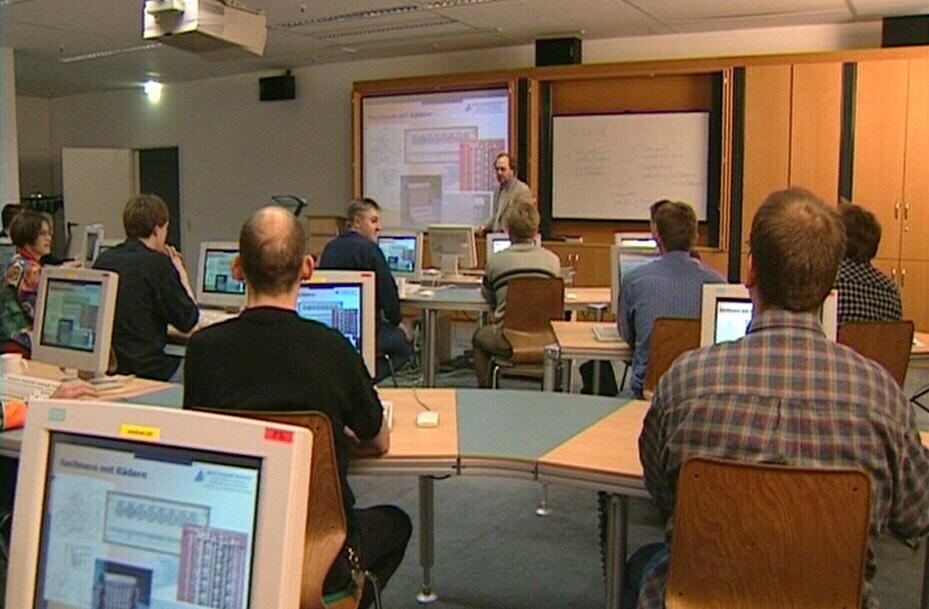
viewer. Interaction takes place between people and not between computers and humans. The interactive teaching theatre is embedded in a digital infrastructure for computer supported cooperative learning ("DISCO"). This provides universal access at all places of learning. Setting up this infrastructure, enhancing and enlarging it, and studying its use under every-day conditions is part of an ongoing joint research effort at the Heinz Nixdorf Institute at the University of Paderborn.
Cooperative learning in classrooms and conference settings
through computer networks
The integration of computers into learning and training is a definite trend. Worldwide communication through computer networks open up utterly new prospects also to learning. There is a call for innovative infrastructures supportive of learners, teachers, study groups and conference participants. The smallest potential unit of a study group or a working team has been the round table.
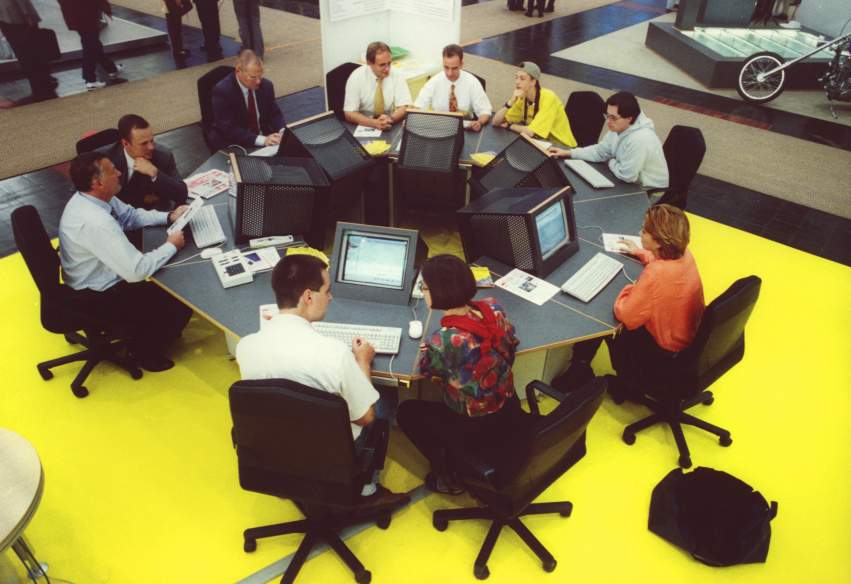 |
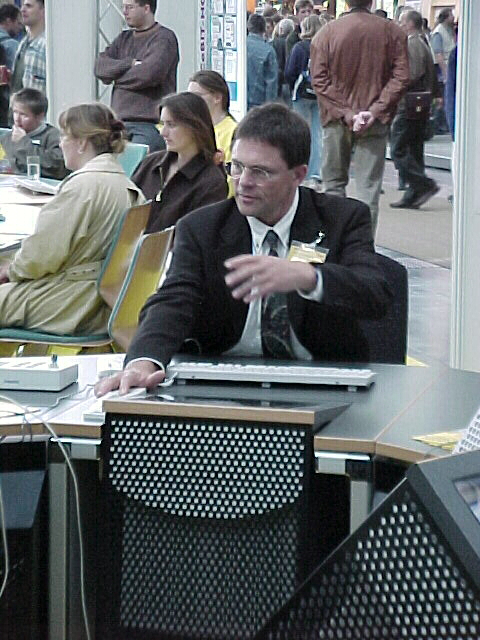 |
The model of a round table with a computer network arranged in a circular form, with fold-away monitors and an interactive control panel was developed by the Heinz Nixdorf Institute and by the Laboratory for Technical Mechanics at the University of Paderborn in co-operation with the Centre for Distance Education at University of Oldenburg and the manufacturer, the Karl Werner GmbH in the city of Paderborn. The round-table promotes work groups, study groups and conferences through worldwide networks. The base model of the round table with 18 seats includes six monitors and can be extended to any size or rearranged in oval or square shapes. It can certainly be adjusted to specific requirements of classroom teaching, team-work or conferences and is equipped with standard appliances. The industrial partner has established the "MiLvA" series of furniture for computer supported co-operative learning and networking. The round table proposes a solution to tomorrow´s learning and training modalities by combining presentation and computer technologies with computer and internet application schemes for teaching support. The round table can easily be advanced to tomorrow´s learning centre or team work-place.
Learning in the business world of banks
Products, tasks and the corporate structures of banks are changing fast and frequently. Thus, traditional formats and means of education and vocational training are not able to keep up with the pace of the recent developments. Learning materials, programmes and tutorials are to be provided on-demand and just-in-time. Not only factual knowledge has to be conveyed, but working and learning teams are to be initiated and supported, as well. Intranets are used by banks to overcome weaknesses of traditional education and training. Intranets comprise texts, images, video, computer conferencing with experts, teachers and colleagues, tutorials, exercises, on-line testing, co-operative working and learning - all in one environment. Our presentations include up-to-date programs of co-operative learning, computer-supported co-operative training and on-line testing. Moreover, demonstrations of innovative media will be provided, such as digital television and virtual bank academies.
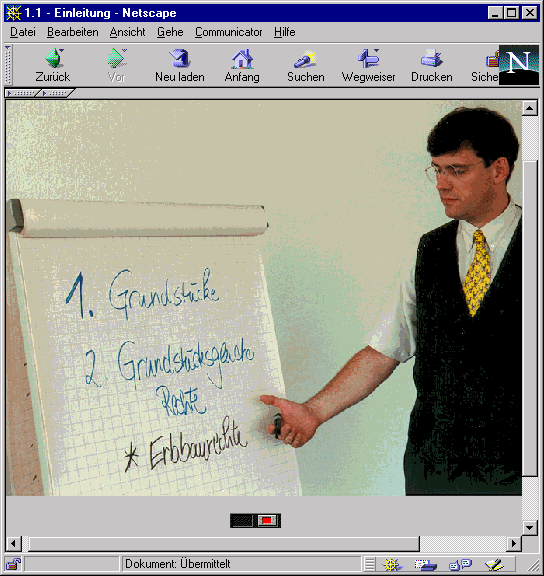
|
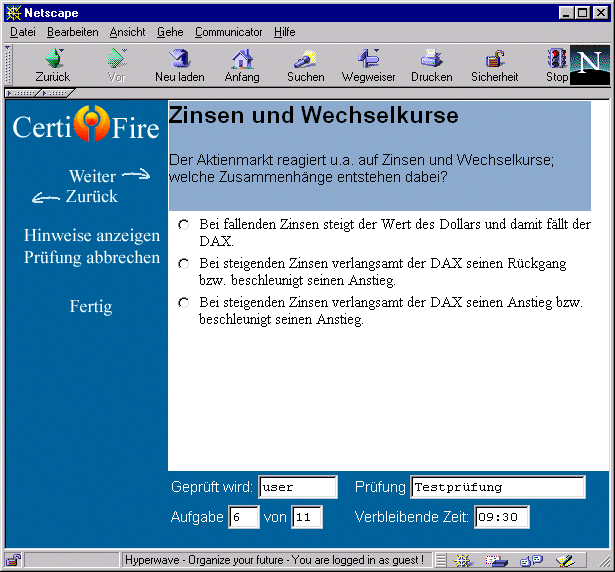
|
A joint initiative by
Ulrich Bernath, Director of the Centre for Distance Education
at the
Carl von Ossietzky University of Oldenburg
E-mail: ulrich.bernath@uni-oldenburg.de
http://www.uni-oldenburg.de/zef/
Joachim Hasebrook, efiport AG in Frankfurt
E-mail: jh@efiport.de
http://www.efiport.de
Reinhard Keil-Slawik, Chairperson of the Heinz Nixdorf
Institute at University of Paderborn and Professor in Computer Science
E-mail:rks@uni-paderborn.de
http://hyperg.uni-paderborn.de/pb_iug